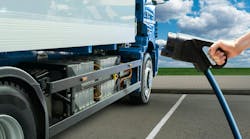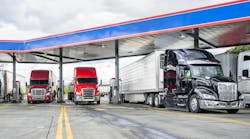Light truck makers are increasingly broadening their “green vehicle” efforts for commercial users and consumers alike, from offering flexible fuel options to gasoline-hybrids, in a bid to reduce pollution and use of fossil fuels simultaneously.
For example, the Chevrolet Silverado and GMC Sierra pickup trucks produced by General Motors can be equipped with 5.3L V-8 engines able to run on gasoline or E85, a blended fuel comprised of 85% ethanol and 15% gasoline.
“It’s increasingly clear that, of anything that we can do over the next decade, ethanol has by far the greatest potential to actually reduce U.S. oil consumption, reduce oil imports, and reduce carbon gas emissions,” said Rick Wagoner, GM chairman & CEO.
“GM now has more than two million E-85 vehicles on the road, with plans to expand production significantly going forward,” he said. “In fact, if all of the E-85 vehicles that GM, Ford, and Chrysler have already built, plus those that we have committed to produce over the next 10 years, were to run on E-85, we could displace 22 billion gallons of gasoline annually.”
Waggoner also noted that E85 ethanol fuel produces fewer greenhouse gases during the combustion process and can enhance engine performance. And while ethanol today is mostly made with U.S.-grown biomaterial, such as corn, GM is helping promote research to turn non-food plant materials such as lumber mill waste, switchgrass, lawn clippings and even garbage into what is called cellulosic ethanol. Unlike corn-based ethanol, the cellulose in the products used to make cellulosic ethanol must be pre-treated and then broken down into sugars before they can be fermented, a step called cellulosis. The technology required to do this is under development, he stressed.
Chevrolet also plans to launch a two-mode hybrid version of its pickups in 2009, based on a system introduced on the 2008 Tahoe sport utility vehicle (SUV). The Tahoe Hybrid full-size SUV uses an all-new electrically variable transmission (EVT), combined with active fuel management, specific aerodynamic aids, lighter components and an electric motor to obtain fuel economy of 21 miles per gallon.
Ford Motor Co. is grouping its alternative efforts under a broad “sustainability” strategy that aims to lessen the overall impact of its motor vehicles on the environment. Intended to guide the company through 2020, the strategy serves as a road map of both near- and long-term technological changes for its products to improve fuel economy, reduce pollution, address climate change and bolster energy security, said Alan Mulally, Ford president & CEO.
The cornerstones of the strategy include a new generation of fuel-saving, turbocharged, gasoline engines for lighter vehicles, weight reductions of 250 to 750 lb., fuel-saving transmissions, advanced electric power steering, aerodynamic improvements, plus more hybrid offerings and diesel engines for light-duty vehicles, added Derrick Kuzak, Ford group vp-global product development.
A new generation of smaller-displacement turbocharged gasoline engines with advanced fuel-saving direct injection technologies is a near-term part of Ford’s plan, engines that can provide a fuel savings of 10% to 20% without compromising performance, he said.
“With direct injection, fuel is injected directly into the combustion chamber in small, precise amounts. When this is combined with turbocharging, customers will enjoy better performance and fewer trips to the gas pump,” Kuzak noted.
Chrysler approved the use of B20 in its diesel-powered Dodge Ram pickups two years ago. B20 is a blended fuel comprised of 80% regular diesel and 20% biodiesel, made from soybeans. A biodiesel blend is also approved for diesel-powered Dodge Sprinter vans.
“Biofuels represent a huge opportunity to reduce fuel consumption and our dependence on foreign oil,” noted Tom LaSorda, vice chairman and president of manufacturing at Chrysler. “While diesel technology alone can make big strides toward helping us meet our national energy, environment and security objectives, when you add biodiesel and other biofuels, it gets really interesting. They are proof that at least part of the solution to our energy, environment and national security issues can be homegrown.”



